Impatiens, petunias, and many other annual flowers are cold-sensitive, and they die away at the first signs of frost. But if you want to continue to enjoy your flower garden and porch planters well into autumn, planting frost tolerant annuals can significantly extend your growing season and add late-season color to your garden too.
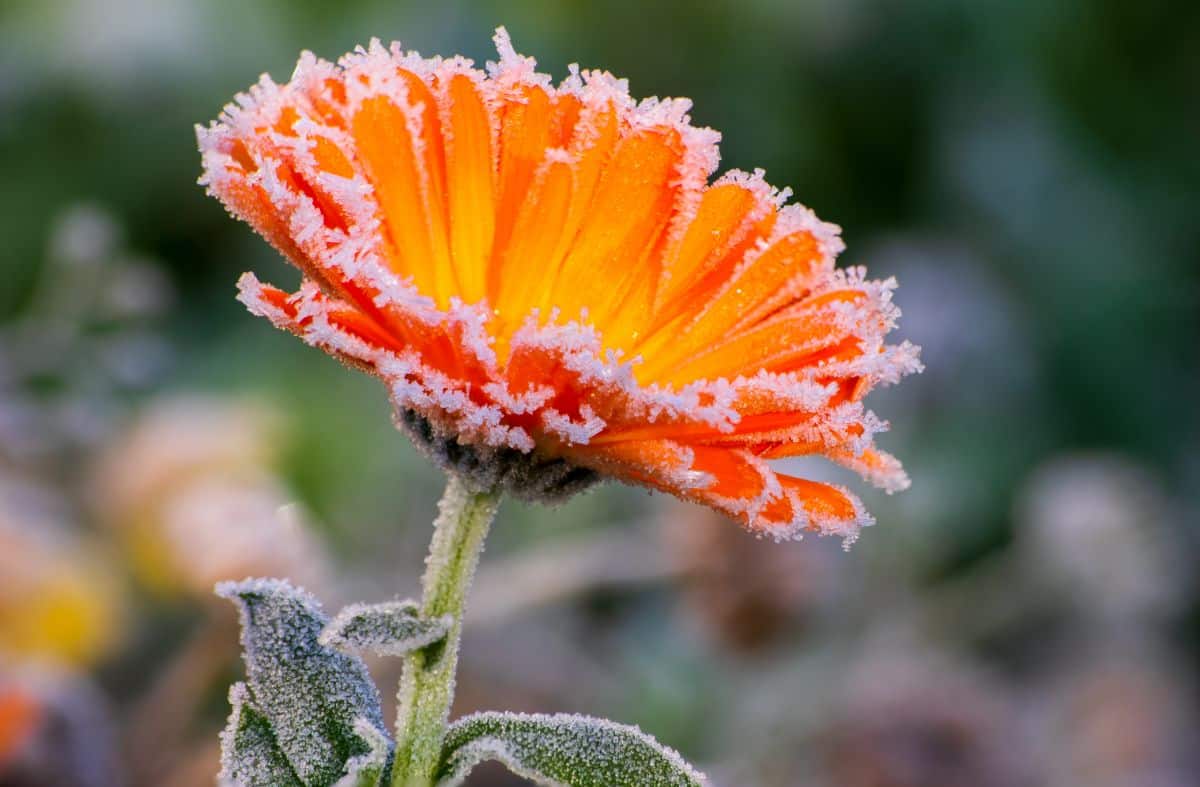
Whether you’re looking for plants for your ornamental garden or you’re on the hunt for just a few hardy outdoor potted plants, this guide will help you find the best annuals to grow in your garden throughout fall and (perhaps) even into early winter!
Jump to:
- 15 frost tolerant annuals to grow in cool weather
- 1. Pansies (Viola tricolor var. hortensis)
- 2. Violas (Viola pedunculata)
- 3. Snapdragons (Antirrhinum spp.)
- 4. Marigolds (Tagetes spp.)
- 5. Mums (Chrysanthemumspp.)
- 6. Calendula (Calendula officinalis)
- 7. Dianthus (Dianthus spp.)
- 8. Bachelor buttons (Centaurea cyanus)
- 9. Stock (Matthiola spp.)
- 10. Sunflowers (Helianthus annus)
- 11. Million bells (Calibrachoa x hybrida)
- 12. Nasturtium (Tropaeolum majus)
- 13. Sweet peas (Lathyrus odoratus)
- 14. Dusty miller (Senecio cineraria)
- 15. Sweet alyssum (Lobularia maritima)
- Frequently asked questions
- Summary
15 frost tolerant annuals to grow in cool weather
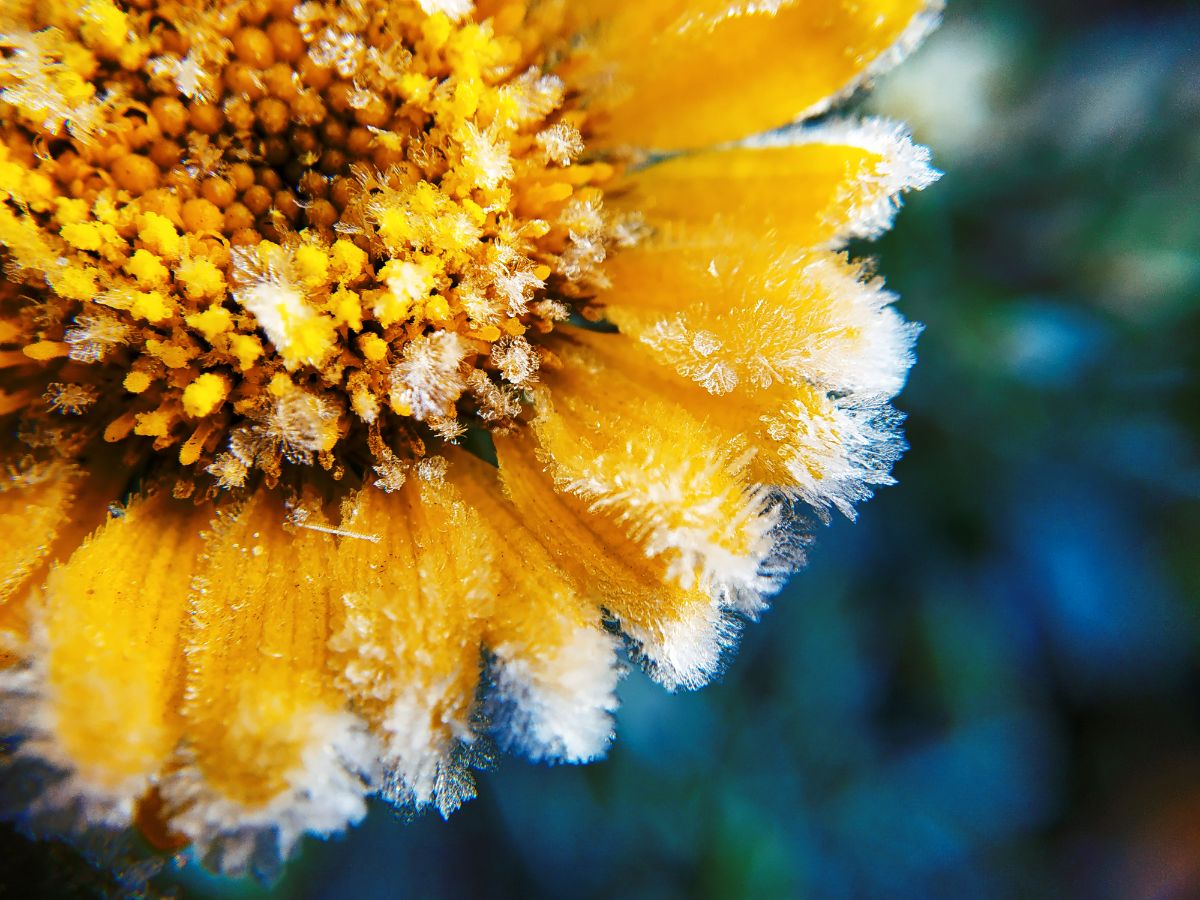
Frost-hardy annuals are incredibly tough plants, and many of them will bounce back beautifully even after a frost or two. While these plants may not withstand a hard freeze, growing cold-resistant annuals in your garden can add weeks or even months to your growing season and keep your garden colorful even into late fall. But if you want to extend your growing season even further, you can always add cloches, frost covers, or overturned cardboard boxes to your annuals when a hard freeze is on the forecast!
1. Pansies (Viola tricolor var. hortensis)
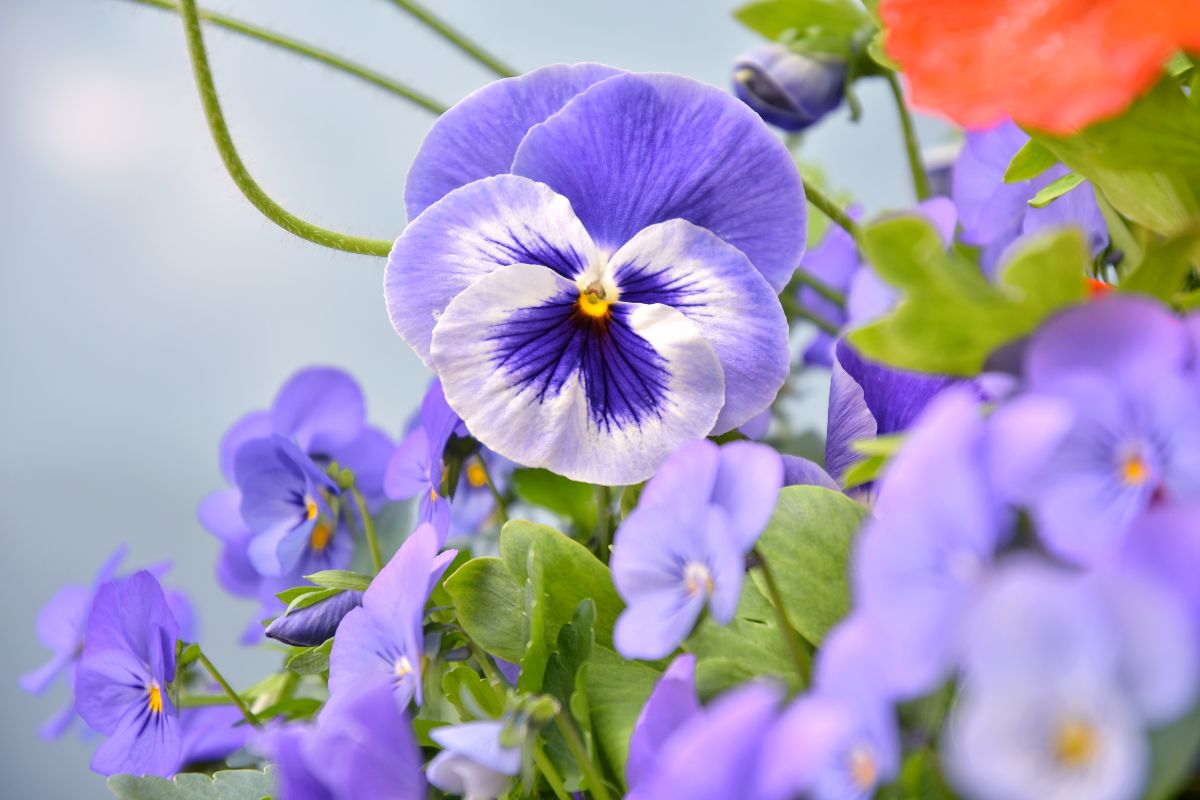
| Plant name: | Pansies |
| Light requirements: | Full sun to part shade |
| Water requirements: | Moderate |
| Growing zone: | Can be grown as perennials in zones 6 to 10 or kept as annuals in cooler locations |
| How hardy? | May survive a hard freeze |
Pansies may look delicate, but looks can be deceiving! Incredibly hardy, pansies can survive cold temperatures, and they can even continue to grow when temperatures drop below freezing. Light frost is no problem for pansies, and pansies may even be able to bounce back after a short, hard freeze.
Since pansies are so resilient in the cold, they are often grown in containers and flower beds in spring and fall. Only growing up to 12” high, pansies are the perfect size to grow towards the front of flower beds, and they also make a colorful border plant. Not to mention, pansy blooms come in just about every color you could want, allowing you to pick the perfect pansy plants to match any garden or home décor!
2. Violas (Viola pedunculata)
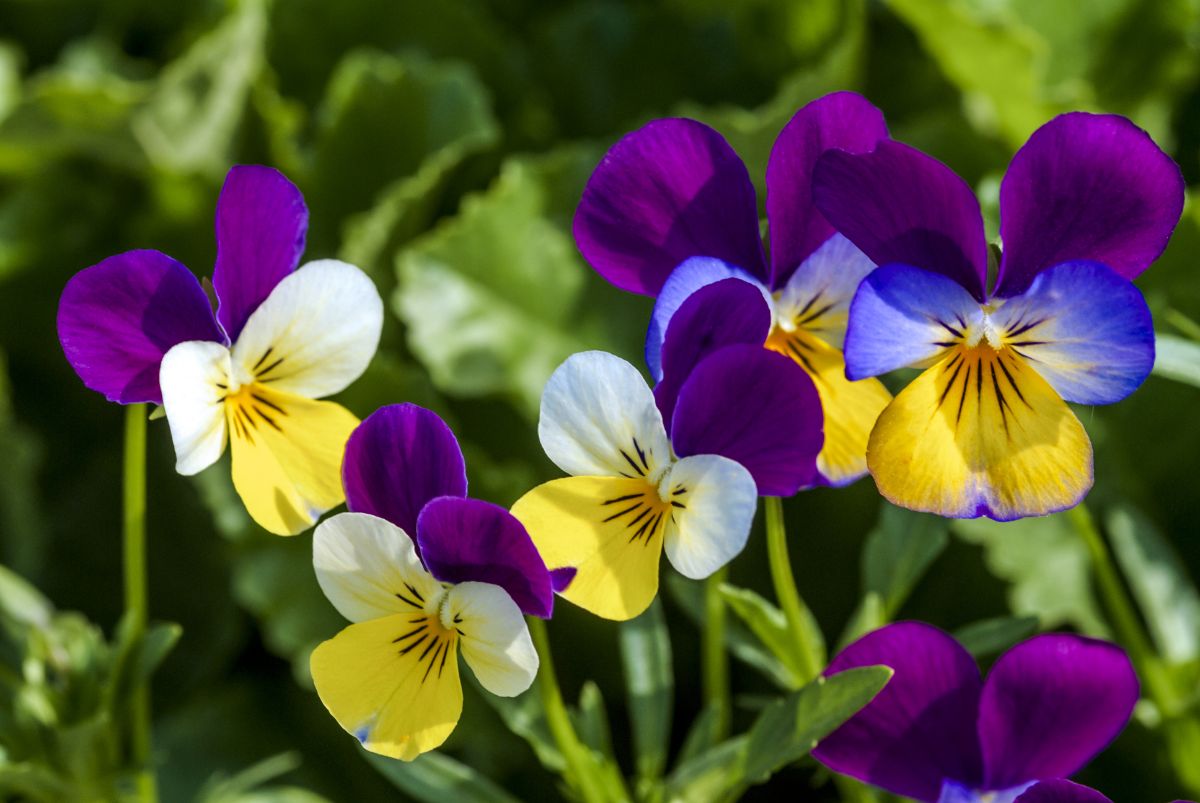
| Plant name: | Violas |
| Light requirements: | Full sun to part shade |
| Water requirements: | Moderate |
| Growing zone: | Zones 3 to 8 |
| How hardy? | May survive a hard freeze |
A close relative of pansies, violas, and pansies look very similar; however, violas typically have smaller flowers, and they have better heat tolerance than pansies too. Like pansies, violas can be grown in flower pots or inground beds, and since these plants stay so compact, they can be planted towards the front of flower beds to add a perfect punch of color. Viola blooms come in a rainbow of hues, including purple, yellow, white, blue, and orange.
In autumn, violas will continue to bloom long after less hardy plants have died back, and violas can even survive a hard frost, as long as temperatures don’t stay cold for a prolonged period of time. These plants are also super easy to start from seed, and you can plant viola seeds around late July and have plants ready to flower in fall. And while violas will always add charm to garden beds, they also press beautifully if you’d like to preserve your flowers through the winter!
3. Snapdragons (Antirrhinum spp.)
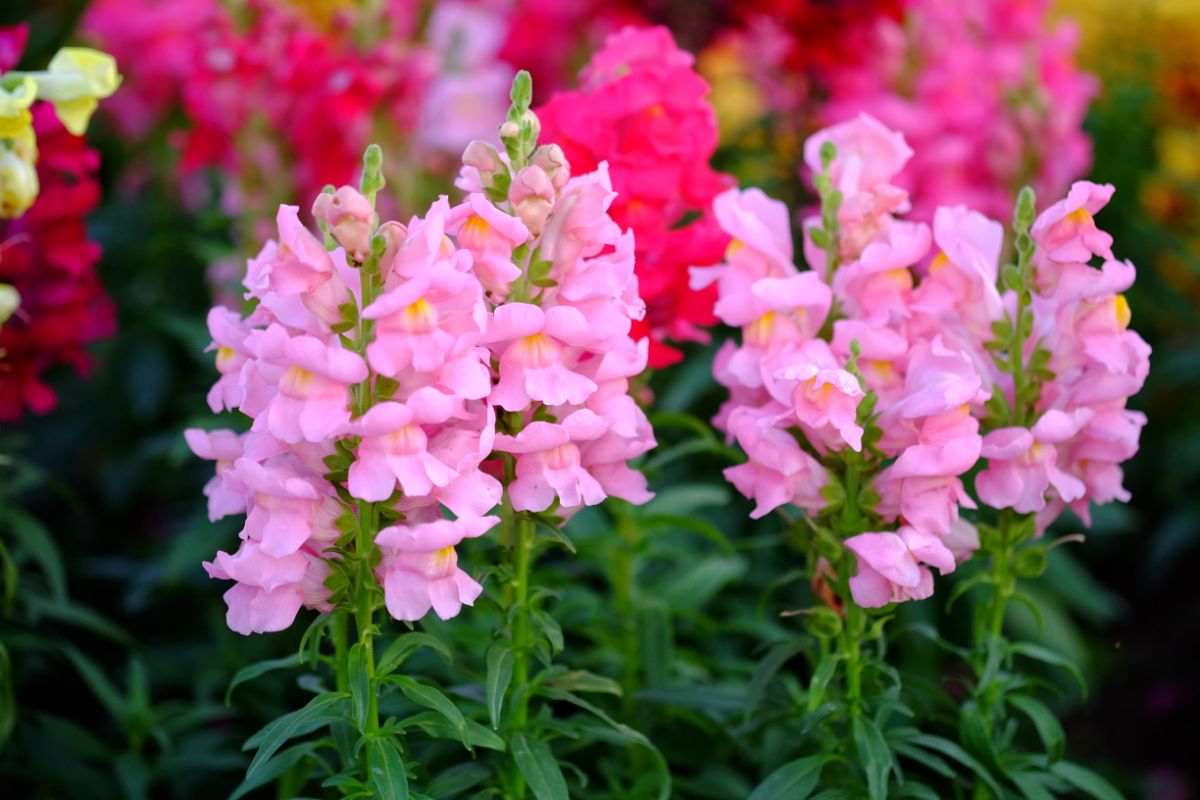
| Plant name: | Snapdragons |
| Light requirements: | Full sun to part shade |
| Water requirements: | Moderate |
| Growing zone: | Can be grown as perennials in zones 7 to 11 or kept as annuals in cooler locations |
| How hardy? | Light frost |
Snapdragons are fast-growing plants that readily sprout from seed, and they can bloom multiple times throughout the growing season, although they do most of their flowering in spring and autumn. These plants come in a wide variety of colors, including yellow, pink, and purple, but they look even more vivid when you plant a medley of snapdragon flowers together. Snapdragons are named for their curiously shaped flowers, which open and shut when gently pressed on their sides -- much like the snapping jaws of a dragon!
Snapdragons will continue to bloom in autumn gardens after other flowers have faded, and these plants can even survive a light frost. Hard frosts tend to be harder on snapdragon flowers, but you may be able to keep your snapdragons flowering by shielding your plants with cloches or an overturned milk jug. Once the cold spell has passed, remove your plant coverings and continue to enjoy these cold-hardy beauties well into fall!
4. Marigolds (Tagetes spp.)
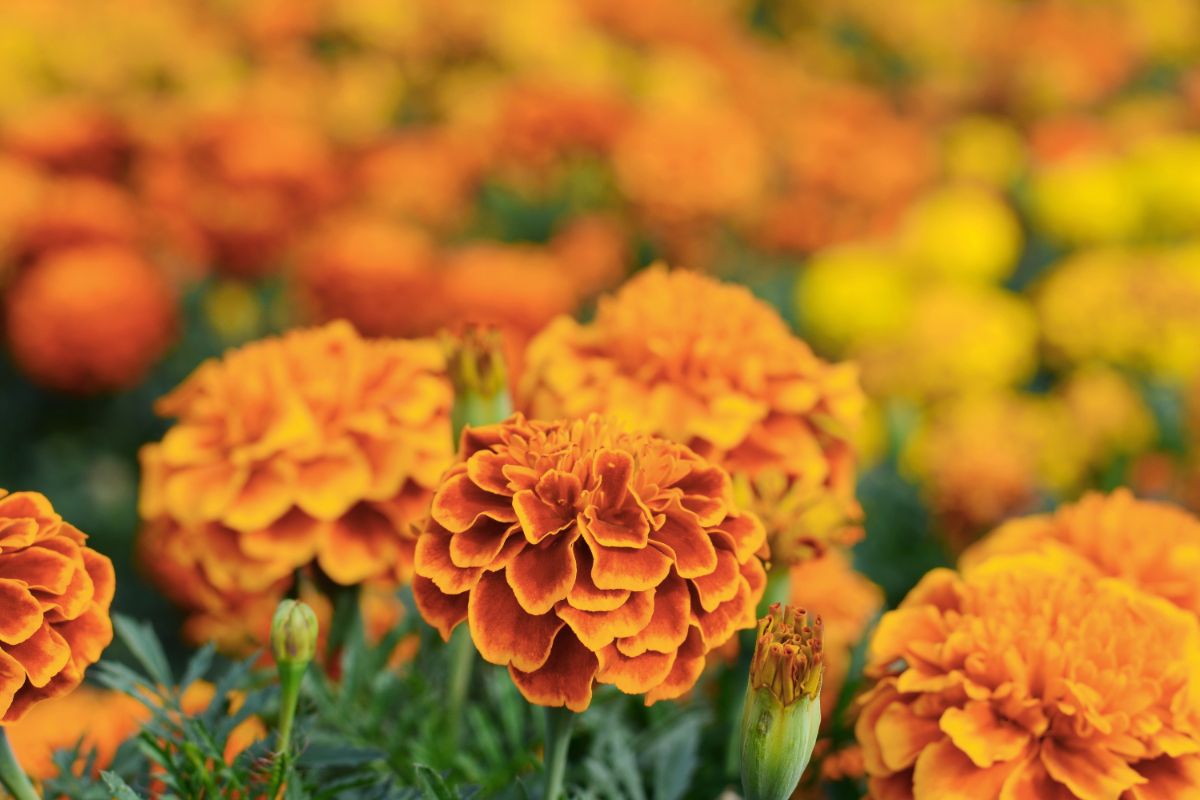
| Plant name: | Marigolds |
| Light requirements: | Full sun |
| Water requirements: | Moderate |
| Growing zone: | Zones 2 to 11 |
| How hardy? | Light frost |
Marigolds are commonly grown as companion plants in vegetable gardens for natural pest control, but these popular plants have tons of ornamental appeal too. Regardless of the size of your garden, you can always find room for marigolds, and these plants grow well in pots and inground beds. Dwarf marigolds are ideal for container growing, while French marigolds tend to be the best marigold varieties for controlling pests.
Regardless of what type of marigolds you choose to keep, these cold-hardy plants can bloom from early summer through fall, and they can even survive light frosts. After flowering, marigold blooms will go to seed, and you can easily collect dried seeds to plant in next year’s garden. If you don’t pick up marigold seeds, these plants also readily self-sow, which is great news if you want new marigold plants!
5. Mums (Chrysanthemumspp.)
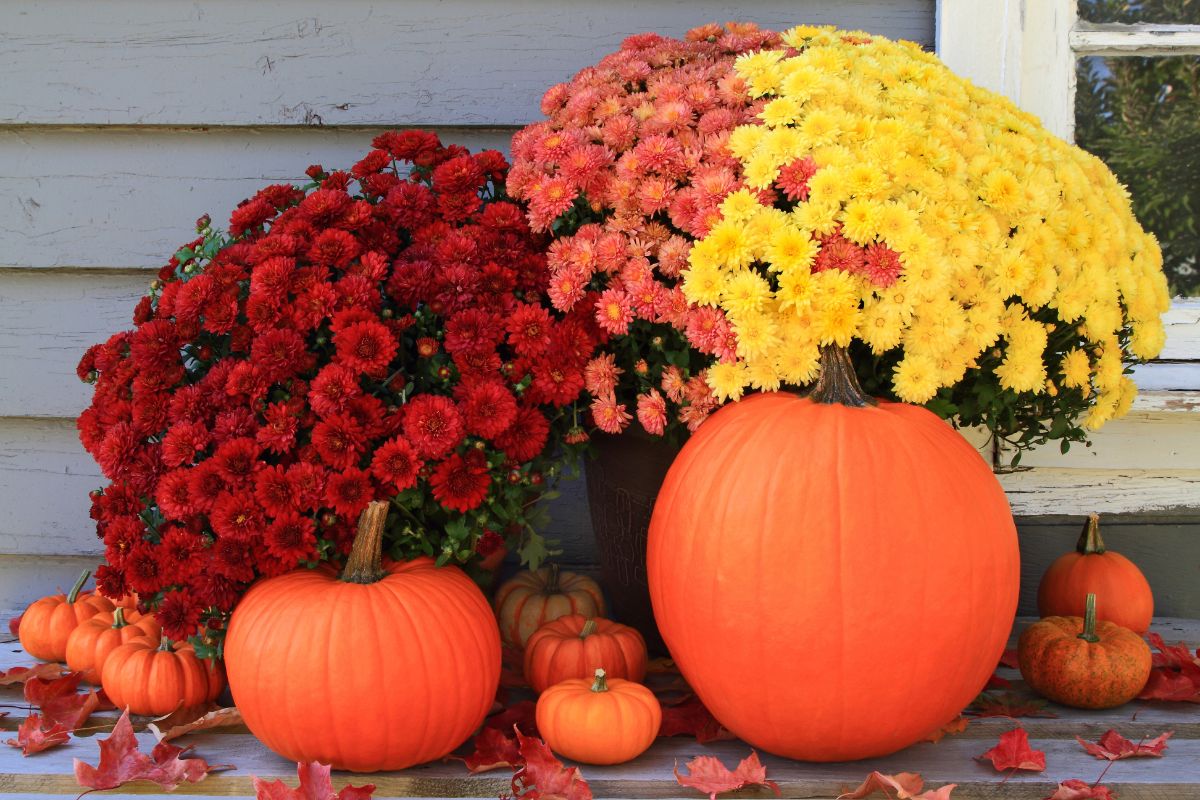
| Plant name: | Mums |
| Light requirements: | Full sun |
| Water requirements: | Moderate |
| Growing zone: | Zones 4 to 9 |
| How hardy? | Light frost |
Mums are classic autumn container plants, prized for their rich bloom colors that come in shades of purple, orange, red, and other traditional fall hues. Some varieties of mums are annuals, while others are perennials, but even annual mums can typically survive a light freeze or two. For extra cold resistance, you may want to try out hardy mums (Chrysanthemum morifolium), which can grow as perennials in areas as cool as zone 4.
In autumn, mums tend to be one of the best-selling plants at garden centers, and you can easily pick up a plant (or 10!) to add a splash of color to front porches and patios. If you pick up hardy mums and transplant them into your garden in autumn, they may tolerate some frosts, but they usually won’t survive the winter. That’s because flowering mums are directing all of their energy towards bloom development, and they often won’t root quickly enough before the ground freezes solid.
6. Calendula (Calendula officinalis)
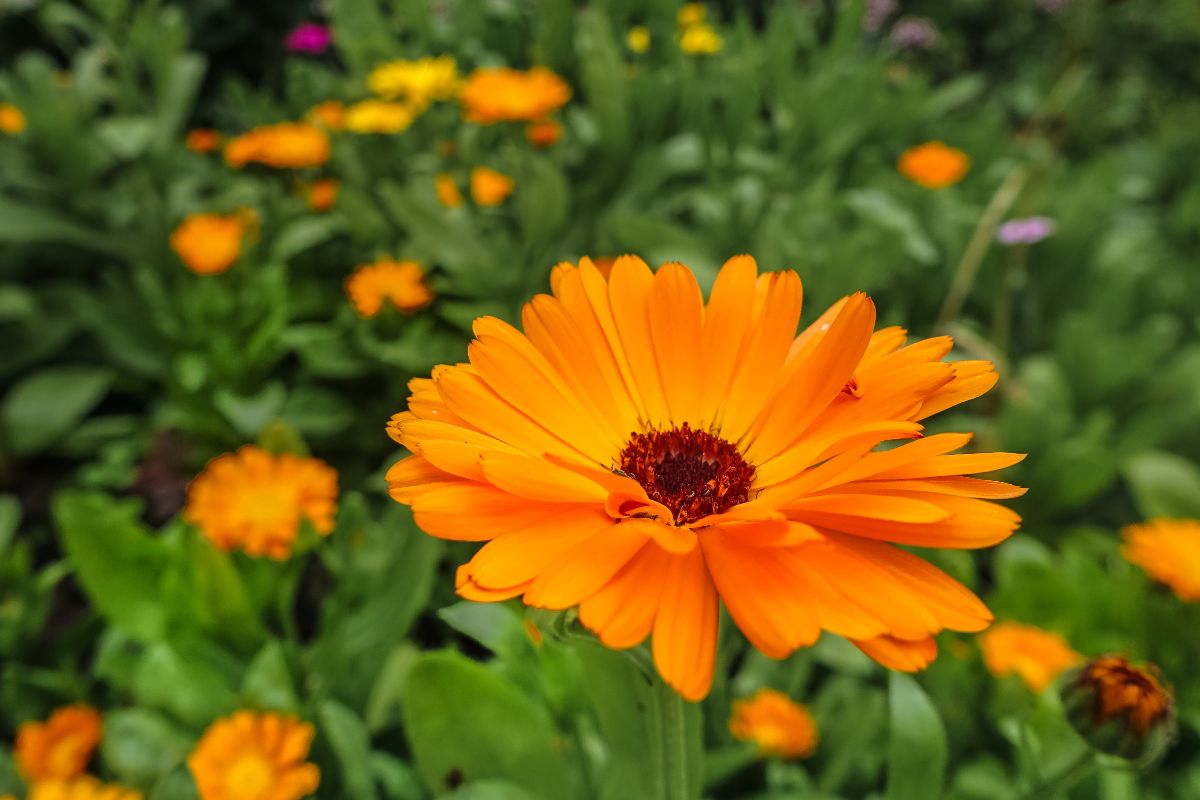
| Plant name: | Calendula |
| Light requirements: | Full sun to part shade |
| Water requirements: | Moderate |
| Growing zone: | Can be grown as perennials in zones 9 to 11 or kept as annuals in cooler locations |
| How hardy? | Light frost |
Also called pot marigolds, calendula are commonly grown as medicinal plants, but they’re also top flowers to grow for pollinators. These easy-going plants continue to flower well into fall, providing much-needed pollen and nectar to insects late in the season. And while calendula plants may look delicate, these plants are quite cold-hardy, and they can handle light frost!
Calendula is easy to grow from seed, but you can sometimes find plants for sale in autumn at local plant nurseries. If you want to start your own plants from seed, directly sow calendula seeds in your garden in spring after the danger of frost has passed. Calendula seeds are also good candidates for succession sowing, and if you plant seeds every 2 to 4 weeks throughout the growing season, you’ll can extend your bloom time and get even more calendula flowers!
7. Dianthus (Dianthus spp.)
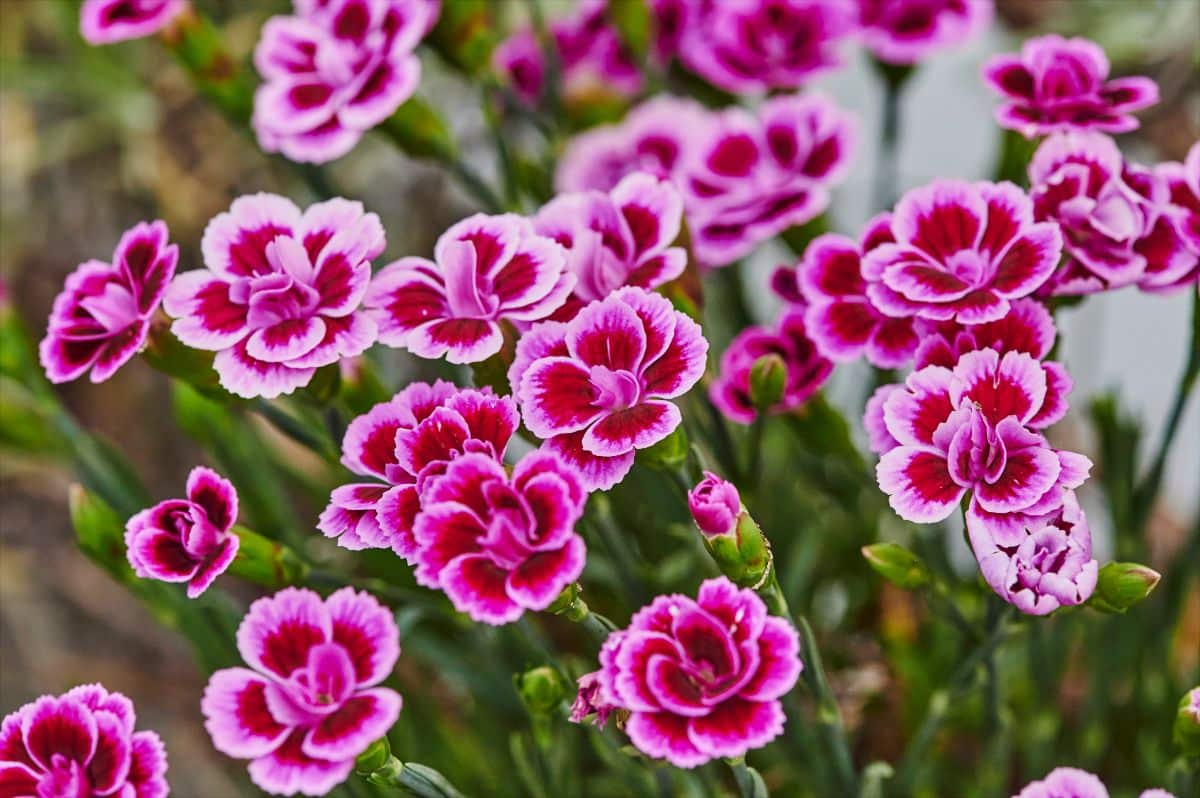
| Plant name: | Dianthus |
| Light requirements: | Full sun to part shade |
| Water requirements: | Moderate |
| Growing zone: | Zones 4 to 8 |
| How hardy? | Light frost |
Dianthus may look dainty, but these flowering annuals can handle cold and light frosts too. A top choice for cutting gardens, dianthus are often used in floral arrangements and bouquets; since dianthus is so cold-hardy, you can even use them in fall bouquets. Plant dianthus in containers or flower beds; it doesn’t matter; these adaptable plants can grow just about anywhere as long as they receive plenty of light.
Although dianthus is commonly kept as annuals, these plants can grow perennially in warmer areas, and some dianthus varieties are adept at self-sowing. Dianthus plants can either be cultivated from seeds or nursery starts, but if you want to grow your own dianthus for autumn gardens, you’ll need to direct sow seeds in early spring. While dianthus is mostly known for its fringed, pink, and white flowers, dianthus leaves add excellent texture to garden beds, and some varieties even sport alluring, greenish-gray foliage!
8. Bachelor buttons (Centaurea cyanus)
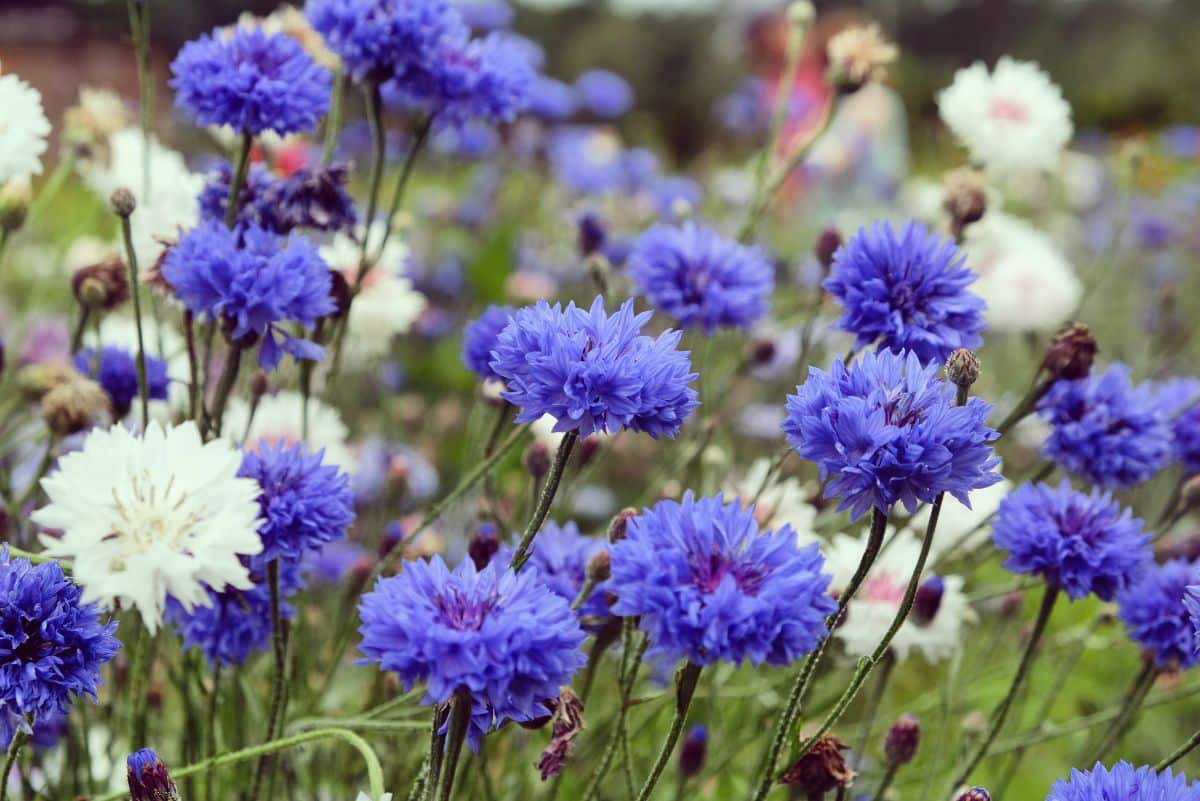
| Plant name: | Bachelor buttons |
| Light requirements: | Full sun |
| Water requirements: | Moderate |
| Growing zone: | Zones 3 to 8 |
| How hardy? | Light frost |
Also known as cornflowers, bachelor buttons are fast-growing annuals that can bloom from summer through fall. Sprouting readily from seed, bachelor buttons are commonly grown in ornamental beds, but they also make fabulous and colorful additions to vegetable gardens. Not only will bachelor buttons add much-needed color to veggie beds, but these plants also yield edible flowers that can be used as garnishes and salad toppers.
Famed for their shaggy blue, purple, or white blooms, bachelor buttons pair beautifully with other cold-hardy plants, like violas and dwarf sunflowers. Established plants can easily survive a light frost, but they won’t make it through hard frosts. After bachelor button flowers fade, you can collect the seeds for seed saving, or you can allow the plants to self-seed themselves in your garden.
9. Stock (Matthiola spp.)
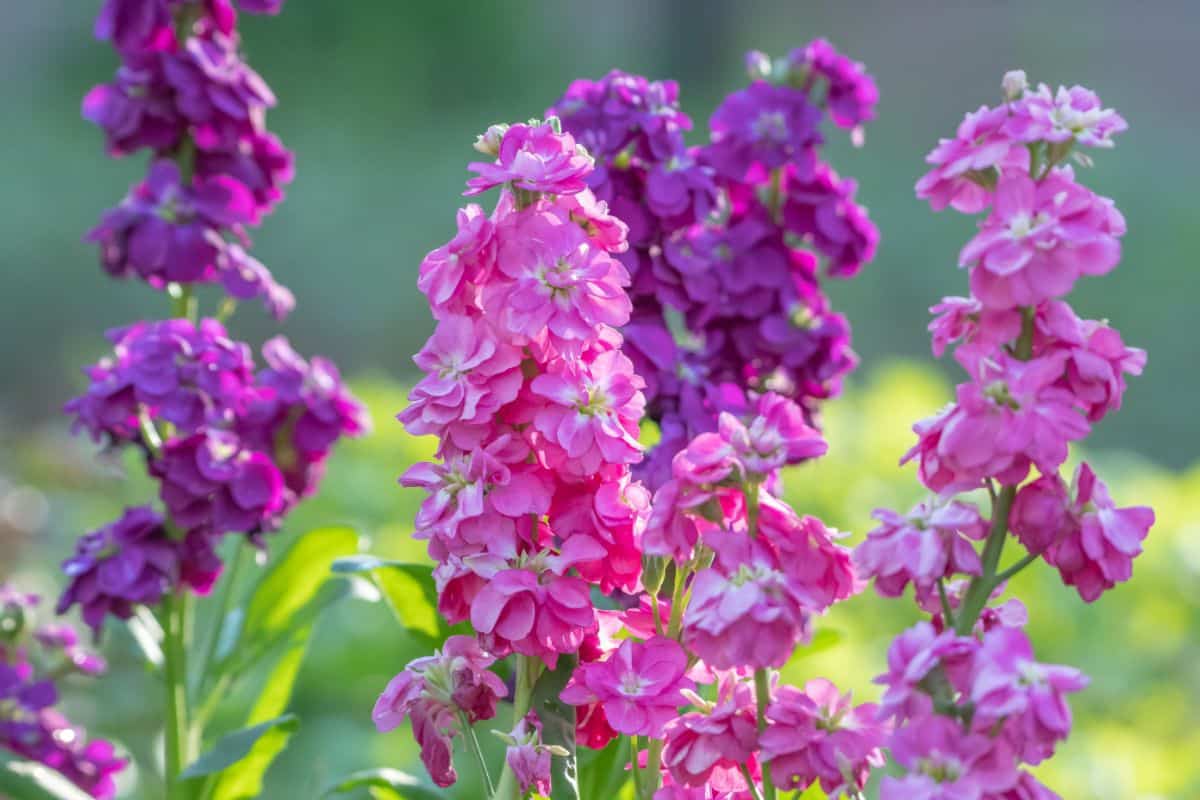
| Plant name: | Stock |
| Light requirements: | Full sun to part shade |
| Water requirements: | Moderate |
| Growing zone: | Can be grown as perennials in zones 7 to 10 or kept as annuals in cooler locations |
| How hardy? | Light frost |
Also known as Gilly flowers, stock has a long and colorful history that stretches back centuries. As the legend goes, stock plants were first introduced to the United States by President Thomas Jefferson, who wanted to sow this fetching plant at his Monticello estate. Stock flowers remained popular well into the Victorian Era, and they are still a top choice for cottage garden designs.
Stock is known for its frilly flowers that come in shades of pink, purple, white, and even bicolor options. When in bloom, stock emits are light clove-like scent, and the flowers are also edible. Since stock doesn’t like hot weather, these plants stop flowering in summer, but some varieties will bloom late into the season, and they can even survive a light frost or two!
10. Sunflowers (Helianthus annus)
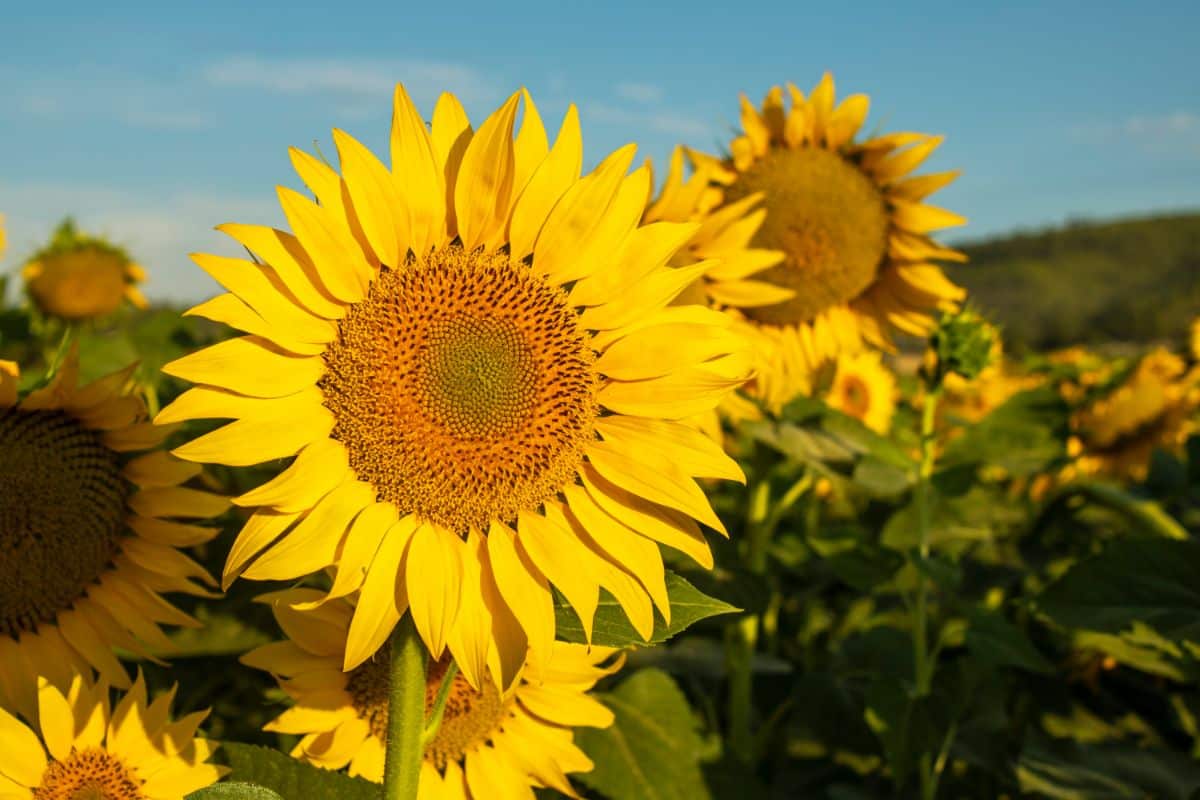
| Plant name: | Sunflowers |
| Light requirements: | Full sun |
| Water requirements: | Moderate |
| Growing zone: | Zones 2 to 11 |
| How hardy? | Mature plants may survive a hard freeze; young plants are more frost sensitive |
Sunflowers are the stars of summer and early autumn gardens, but sunflowers can resist cold temperatures and some frost if they’re mature. Sunflowers in the R7 stage (when the back of the flowerhead begins to yellow) can withstand temperatures as low as 25F, although younger, more tender sunflowers may not make it through severely cold weather. Planting a mixed bed of sunflowers and other autumn favorites can give your garden a very seasonal look, or you can keep dwarf sunflowers in a porch planter with a few decorative pumpkins!
When most people think of sunflowers, they think of plants with long stalks and sunny yellow petals. However, you can also find sunflowers with unique flower colors, including maroon and pure white blooms, or you can try out sunflowers with frilly flower shapes, like ‘Teddy Bear.’ Some sunflowers mature faster than others, though, so be sure to consult your seed packet to determine the best time to plant sunflowers for autumn blooms!
11. Million bells (Calibrachoa x hybrida)
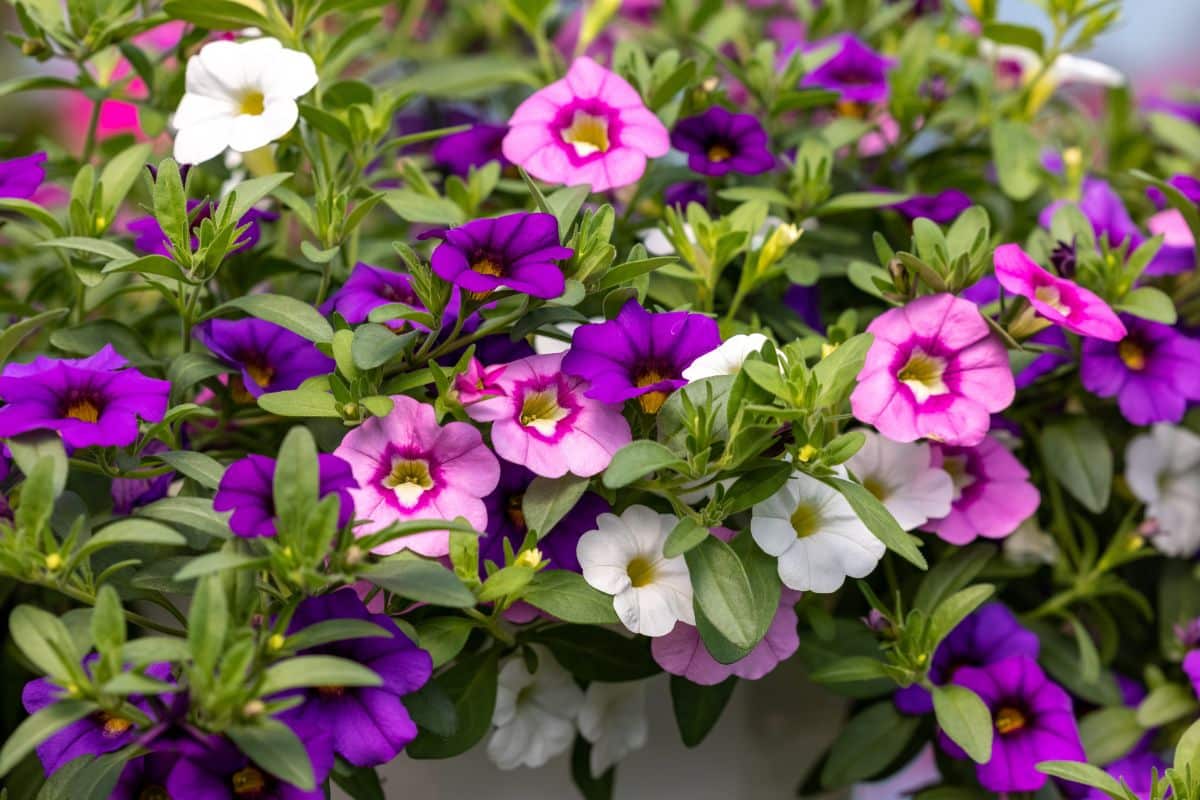
| Plant name: | Million bells |
| Light requirements: | Full sun to part shade |
| Water requirements: | Moderate |
| Growing zone: | Can be grown as perennials in zones 9 to 11 or kept as annuals in cooler locations |
| How hardy? | Light frost |
First introduced in the 1990s, million bell plants (also known as trailing petunias) are a relatively new, hybrid species created from plants from South America. These trailing flowers are commonly potted up in porch planters and hanging baskets, but they can also be used in sunny spots as a groundcover. Enchantingly colorful, million bell plants have blooms that look like miniature petunias, and they come in a rainbow of colors, including purple, pink, blue, yellow, and bronze.
In warm locations, a million bells can grow perennially, but this plant is mostly kept as an annual in cooler spots. And while hard freezes are a “no-go,” million bells can survive a mild frost, and they can even tolerate cooler weather with a bit of protection. To keep your plants happy, pot your million bells in rich, well-draining, and slightly acidic soil and keep them in full sun to part shade.
12. Nasturtium (Tropaeolum majus)
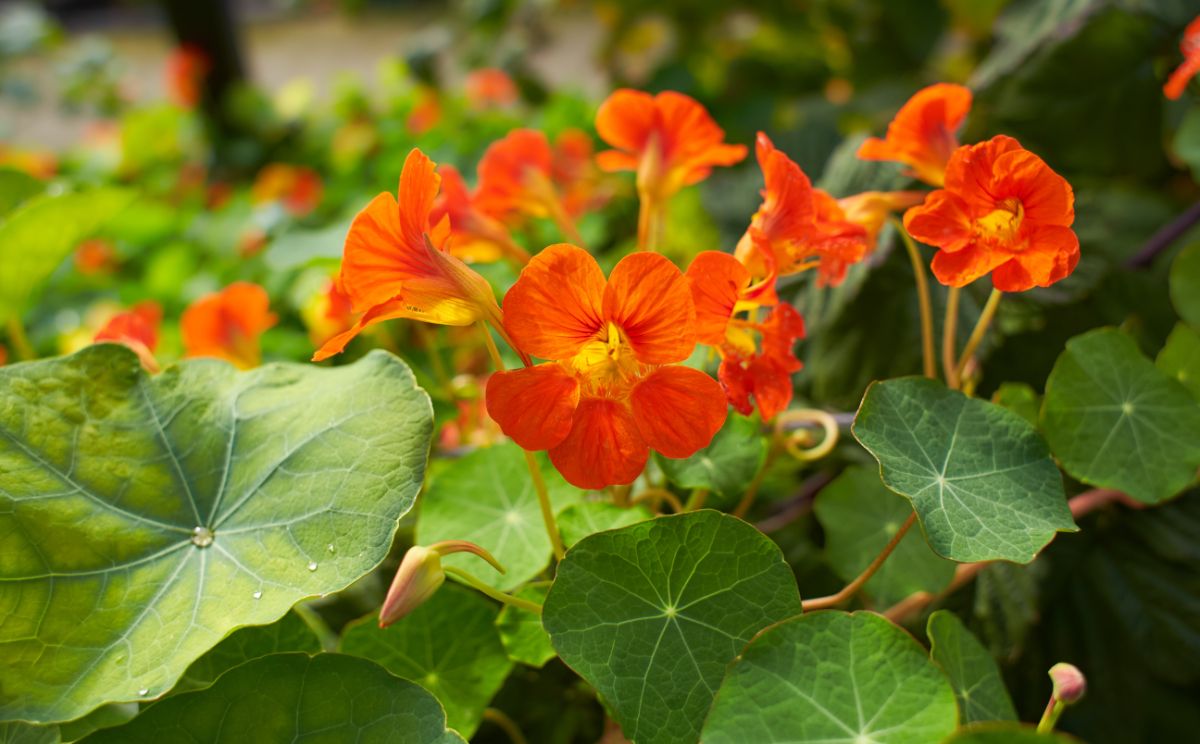
| Plant name: | Nasturtium |
| Light requirements: | Full sun to part shade |
| Water requirements: | Moderate |
| Growing zone: | Can be grown as perennials in zones 9 to 11 or kept as annuals in cooler locations |
| How hardy? | Light frost |
With scalloped leaves and trumpet-shaped flowers, nasturtiums are striking-looking plants that fit right into flower gardens, veggie beds, and porch planters too. You can find nasturtium with orange or yellow blooms, and some cultivars even have variegated leaves for even more fantastic color. Trailing-type nasturtiums are particularly well suited for hanging baskets and planters, while mounding nasturtiums won’t sprawl in garden beds.
Nasturtium plants are usually grown from seeds, which can be directly sown in garden beds a week or two after your last frost date. Edible and delicious, nasturtium leaves and flowers can be added to salads and other recipes, or you can keep these plants purely for their aesthetic appeal. Even when temperatures drop, nasturtium plants will continue to bloom, and they can survive light frosts but not hard freezes.
13. Sweet peas (Lathyrus odoratus)
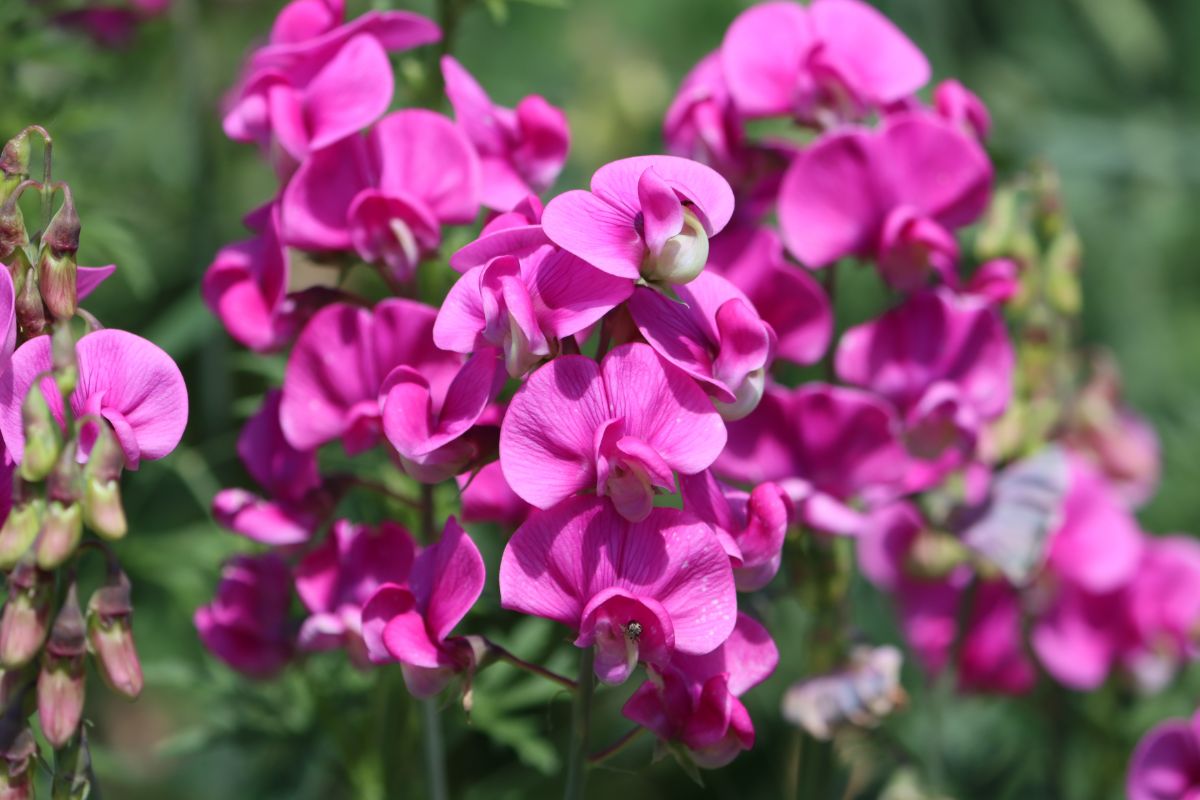
| Plant name: | Sweet peas |
| Light requirements: | Full sun |
| Water requirements: | High |
| Growing zone: | Zones 3 to 8 |
| How hardy? | Light frost |
Dainty sweet peas may not look like they can handle cold temperatures, but these tough plants survive frosts and below-freezing temperatures! As long as the weather is relatively dry, sweet peas can tolerate temperatures as low as 25F, but they’re more likely to suffer damage in cold and humid conditions. Considering how hardy these plants are, it’s no wonder why sweet peas are some of the top plants to grow in spring and autumn gardens!
While sweet peas are champs in cool weather, they don’t tolerate heat, and plants will fade during summer. If you planted sweet peas in spring, you may want to plant a second crop of plants in mid-summer to early fall for a second flush of flowers. In mild climates, sweet peas can even be planted as late as November!
14. Dusty miller (Senecio cineraria)
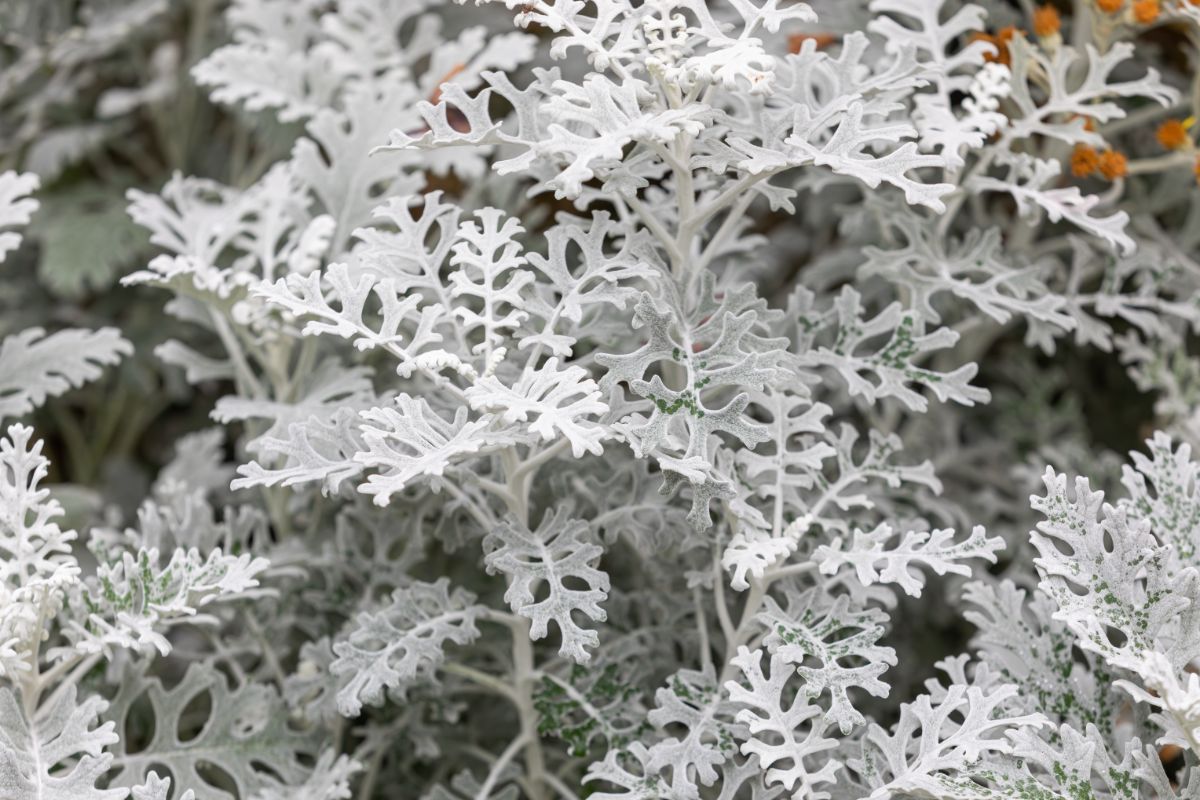
| Plant name: | Dusty miller |
| Light requirements: | Full sun to part shade |
| Water requirements: | Moderate |
| Growing zone: | Can be grown as perennials in zones 7 to 10 or kept as annuals in cooler locations |
| How hardy? | Light frost |
A top-notch plant for planters and window boxes, dusty miller is sure to draw the eye in inground plantings too! As a popular foliage plant, dusty miller is mostly known for its silvery leaves, but this ornamental is also cold-hardy, and it can survive light frosts in spring and autumn. For colorful fall plantings, dusty miller is often paired with marigolds or mums, but it can also be used to accentuate cottage garden favorites like stock.
Most often, gardeners grow dusty miller plants from nursery-started plants, but dusty miller can also be grown from seed to save money. Seeds take a while to grow, so they should be started indoors in spring, about 8 to 10 weeks before your last frost date. As your dusty miller plants grow, remember to always water your plants at the soil line, as dusty miller doesn’t like wet leaves!
15. Sweet alyssum (Lobularia maritima)
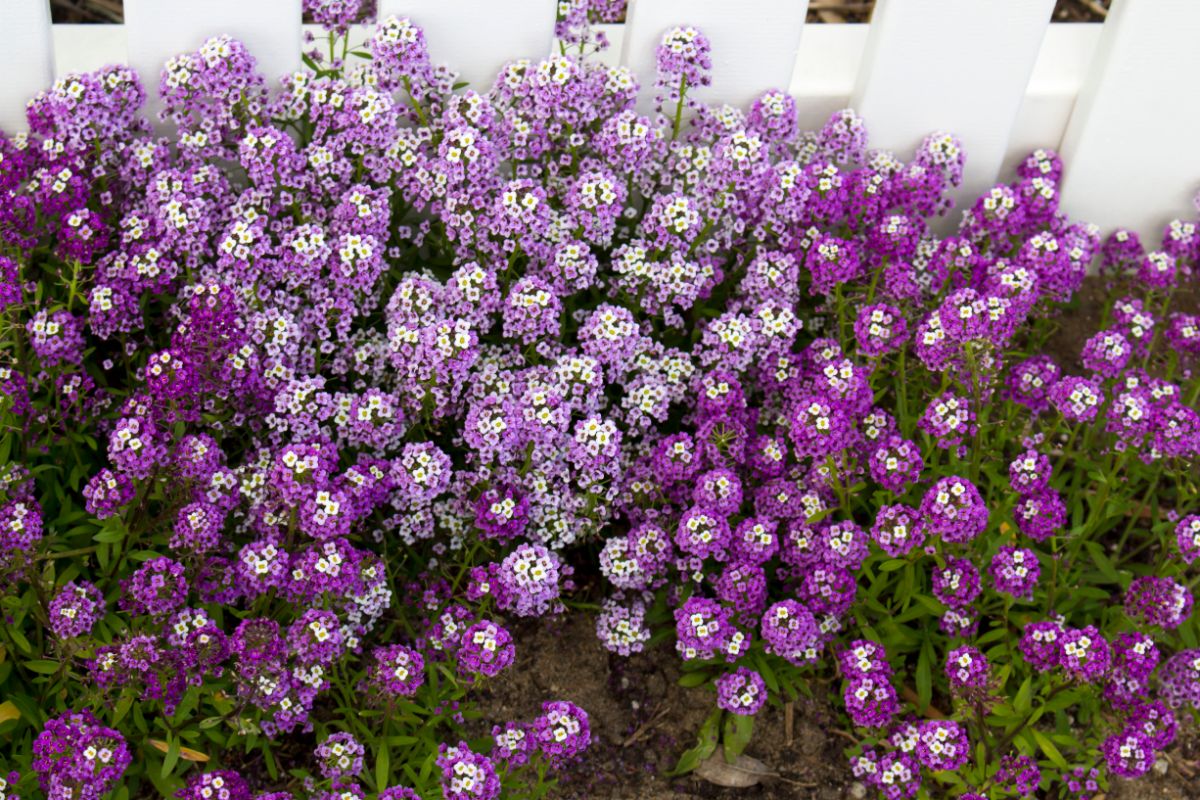
| Plant name: | Sweet alyssum |
| Light requirements: | Full sun to part shade |
| Water requirements: | Moderate |
| Growing zone: | Zones 5 to 9 |
| How hardy? | Older plants can often survive a light frost; young plants do not tolerate frost |
Bees, butterflies, and hummingbirds flock to sweet alyssum blooms when the weather is warm, but even in cooler weather, sweet alyssum remains a delight for the senses. Prolific bloomers, sweet alyssum plants produce tight, mounding clusters of purple and white flowers, which emit a sweet, honey-like fragrance that’s hard to resist. During hot weather, sweet alyssum will often stop blooming, but plants will perk right up as soon as temperatures mellow out.
As they mature, sweet alyssum maintains a low and spreading growth habit, which makes them ideal for porch planters and hanging baskets. Depending on your growing space, you can also use sweet alyssum as a colorful border plant or a low-fuss groundcover. Once established, sweet alyssum plants can withstand light frost, but young plants may suffer from cold damage.
Frequently asked questions

Some hardy annual plants can withstand light frost and temperatures below freezing. Hard freezes, however, tend to be much harder for even tough annuals to withstand. Sturdy, cool weather plants like sweet peas may be able to tolerate temperatures as chilly as 25F, but most annuals die back when temperatures drop below freezing.
Petunias love hot climates, but they typically struggle in cooler weather. Most petunias can tolerate temperatures down to 40F; however, Wave petunias were specially developed to be more cold-hardy, and they can handle temperatures as low as 35F.
No. While impatiens are flashy additions to summertime gardens, they don’t tolerate cold well, and they are killed by frost.
If you want to extend your growing season and protect your annuals from hard frosts, adding cloches or frost covers over your plants can help. Budget-minded gardeners may prefer to shield their plants with lightweight bedsheets, overturned cardboard boxes, or milk jugs with the tops cut off.
Porch planters and pots are often rated as ‘frost resistant’ or ‘frost proof,’ which refers to their ability to withstand cold temperatures. ‘Frost resistant’ planters are more sturdy than pots with no rating, but they may still break in very cold weather. ‘Frost proof’ pots, on the other hand, should be able to withstand hard frosts with no problem at all!
Ideally, yes. Water-stressed plants are less likely to survive frosts, so if you know frost is expected, it’s always a good idea to water your plants. Water your plants deeply at the soil line, but don’t overdo it, and try to keep the plant leaves dry if possible.
Summary
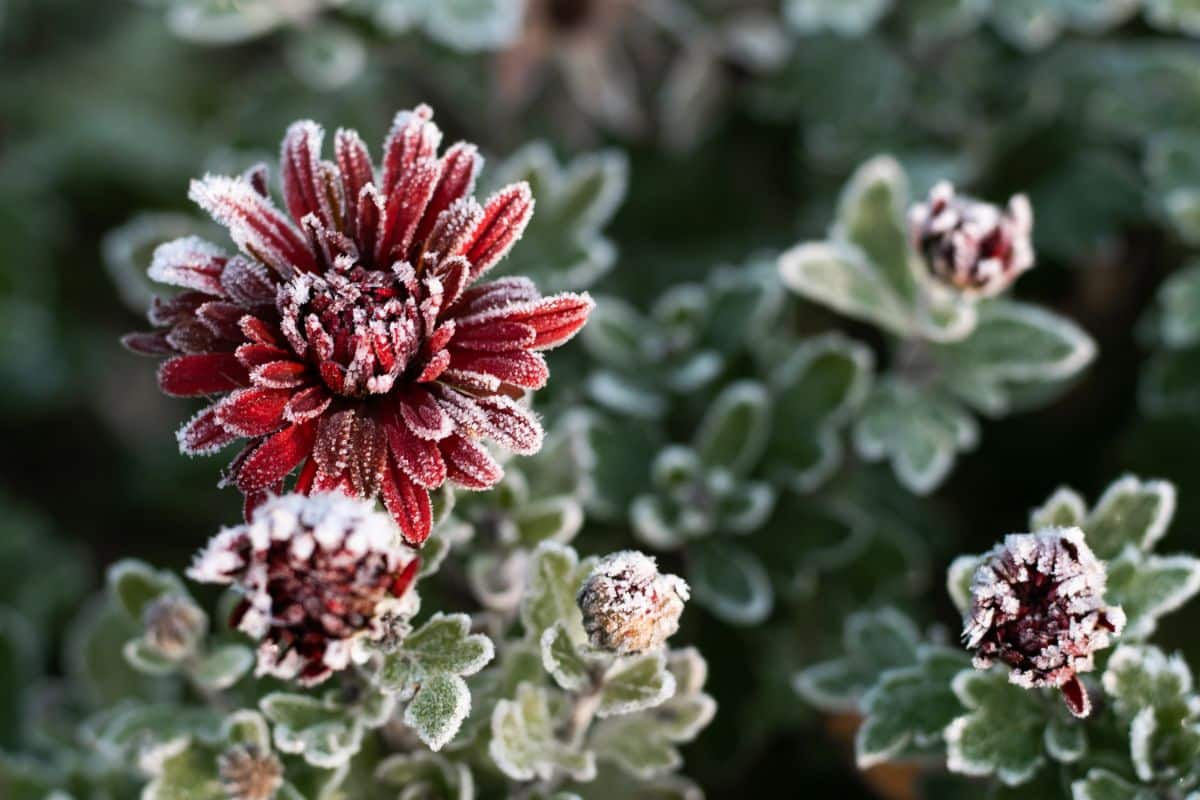
With the right cold-hardy annuals and a bit of frost protection, you can extend your growing season by a few weeks or months and continue to relish colorful, homegrown flowers well into fall. But once your annual plants eventually fade, you can keep your garden lively throughout winter with these winter interest plants. And don’t forget to plant some spring ephemeral bulbs in autumn to get even earlier blooms in spring!

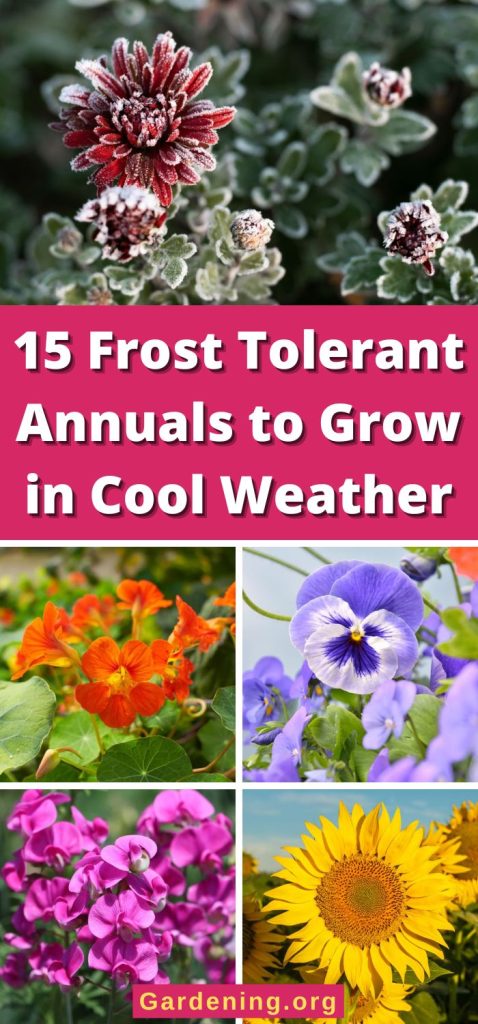
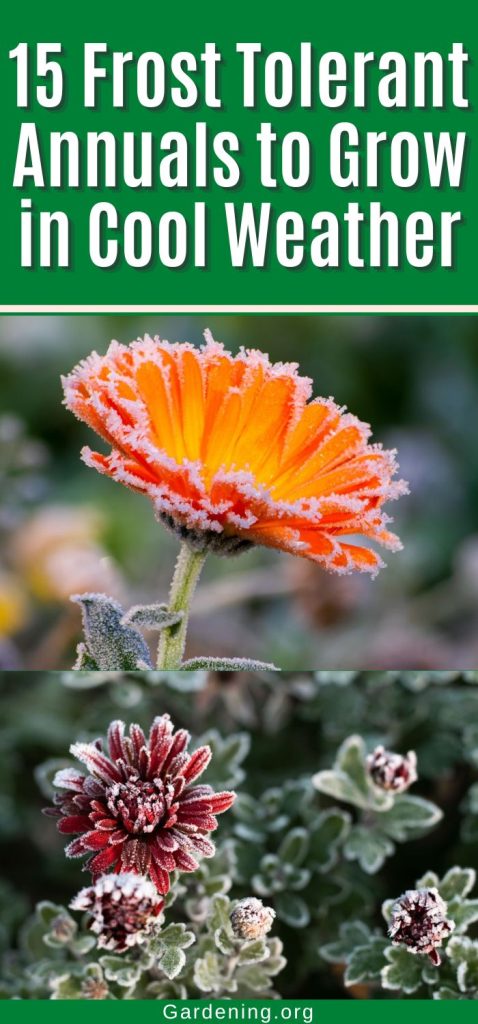
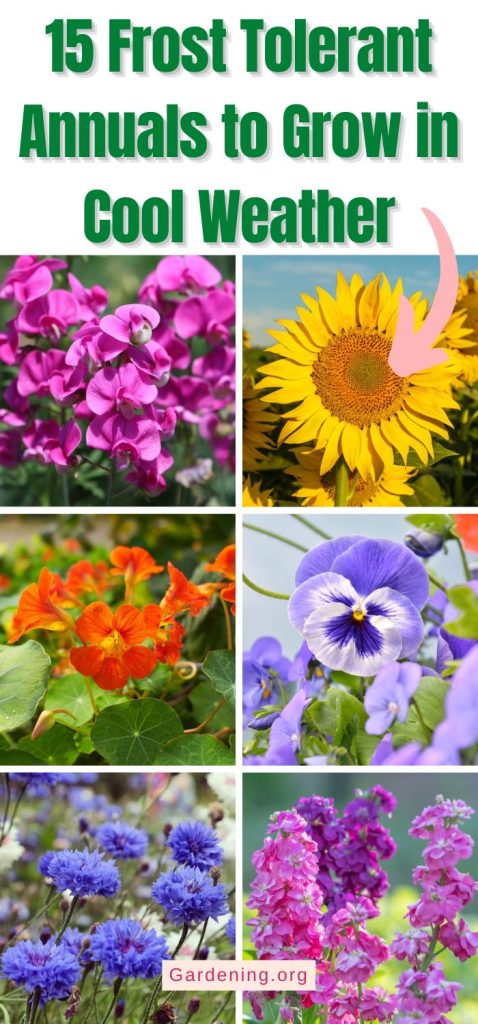
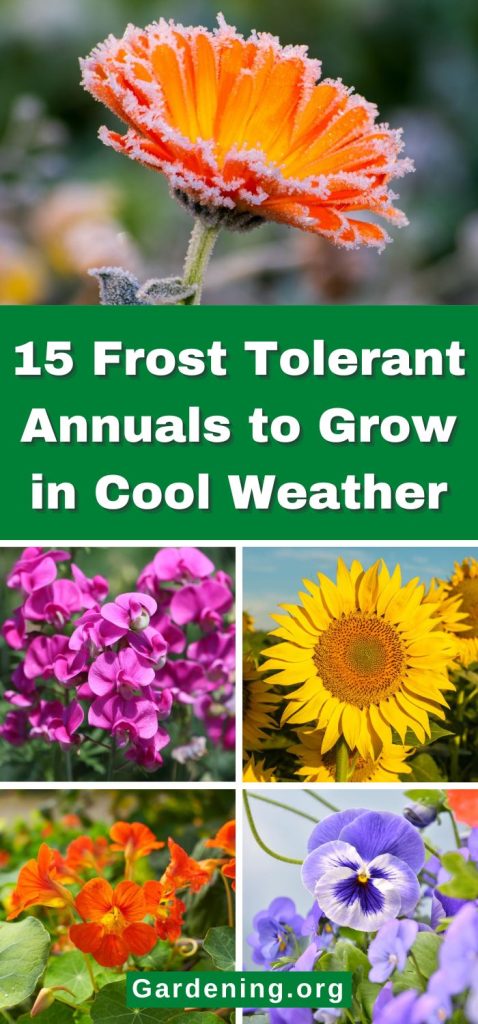

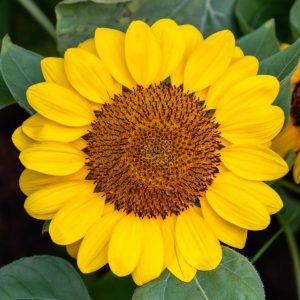
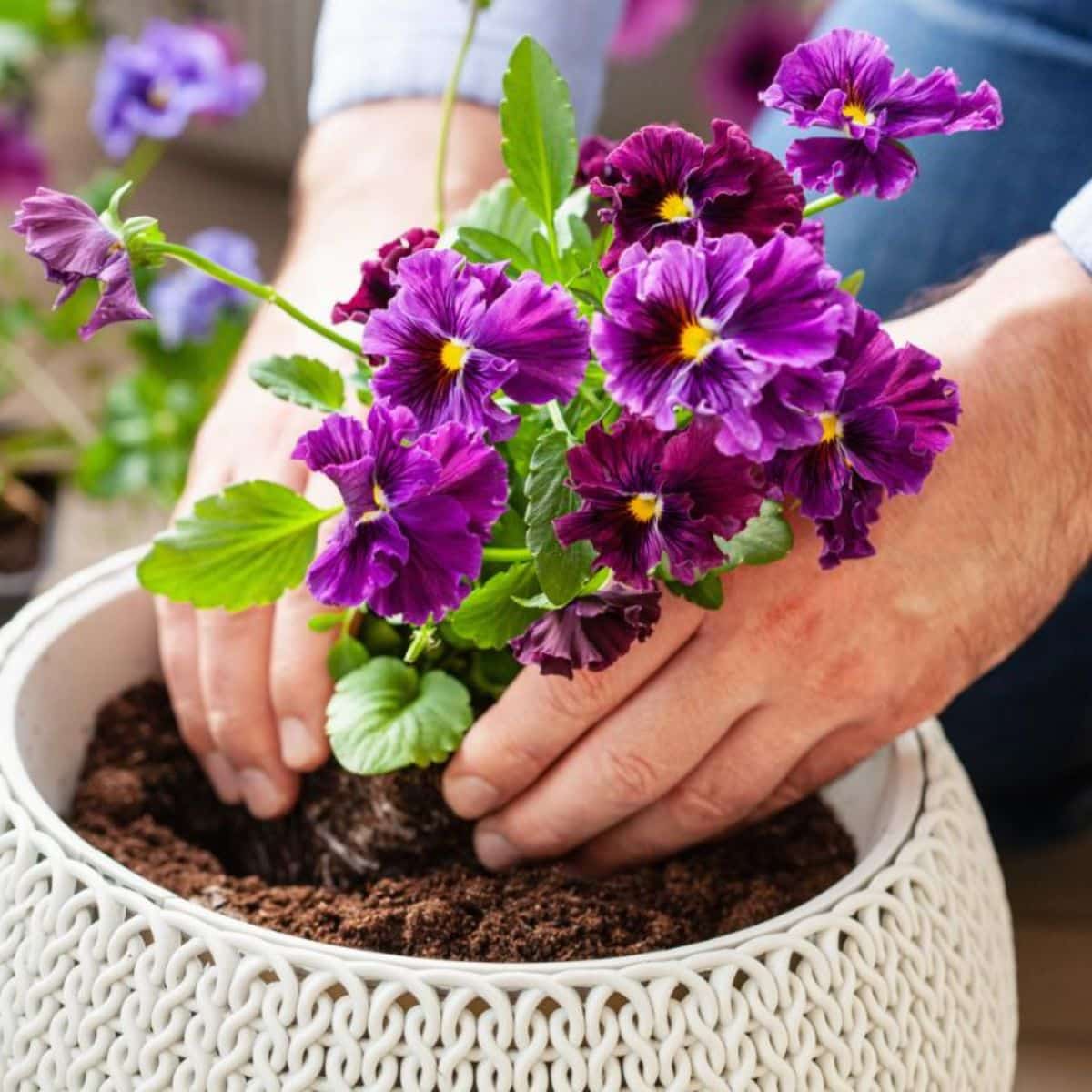
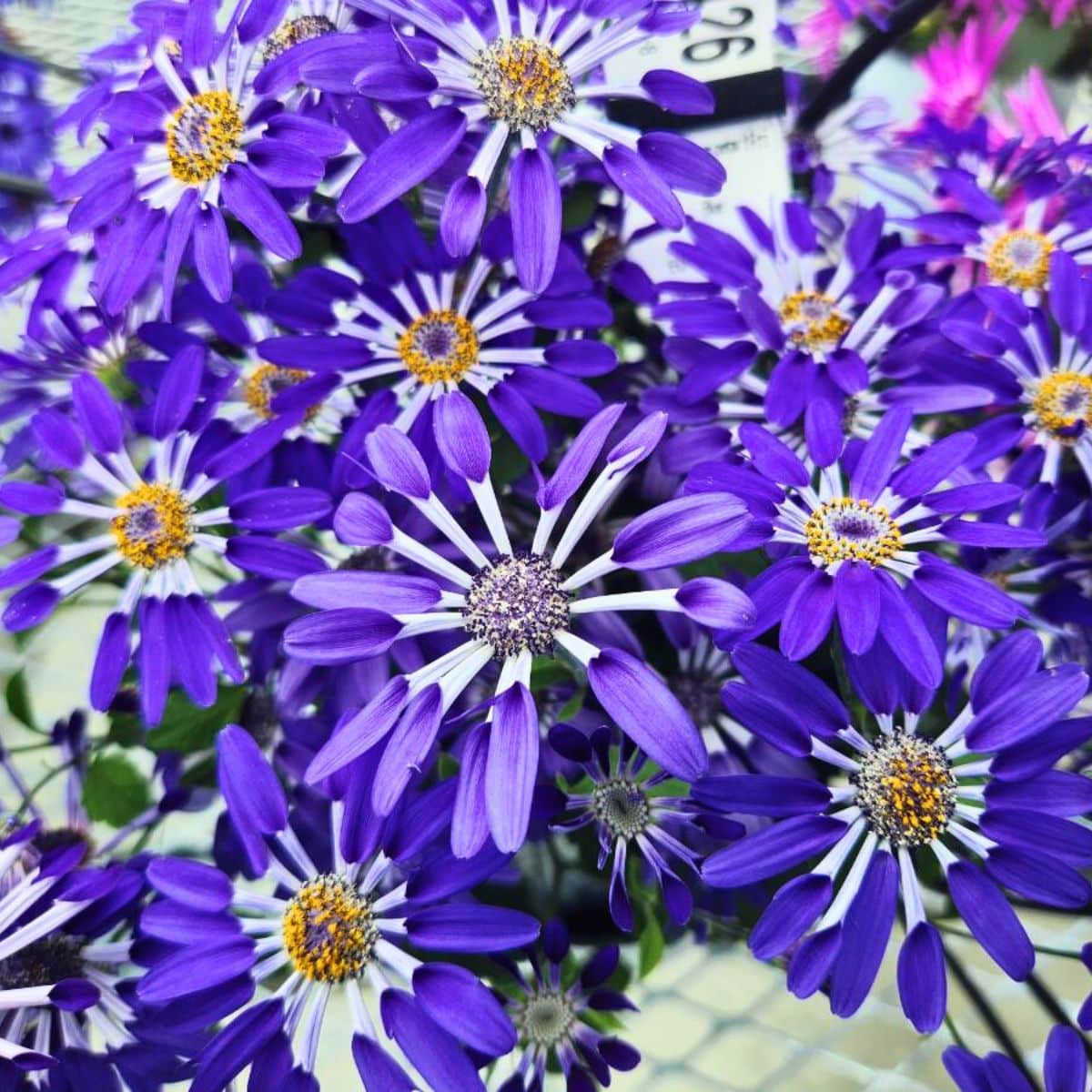
Peter Iveson iveson
Nastursiums are not frost tolerant
Mary Ward
They can survive a light frost down to 30F and can do better if they are covered and experience intermittent low temperatures with temps that rise during the day. This is true of several flowers on this list, including mums--they should still be covered. They earned a spot on this list due to their ability to bloom in low temperatures above freezing. Not many flowers can do that.